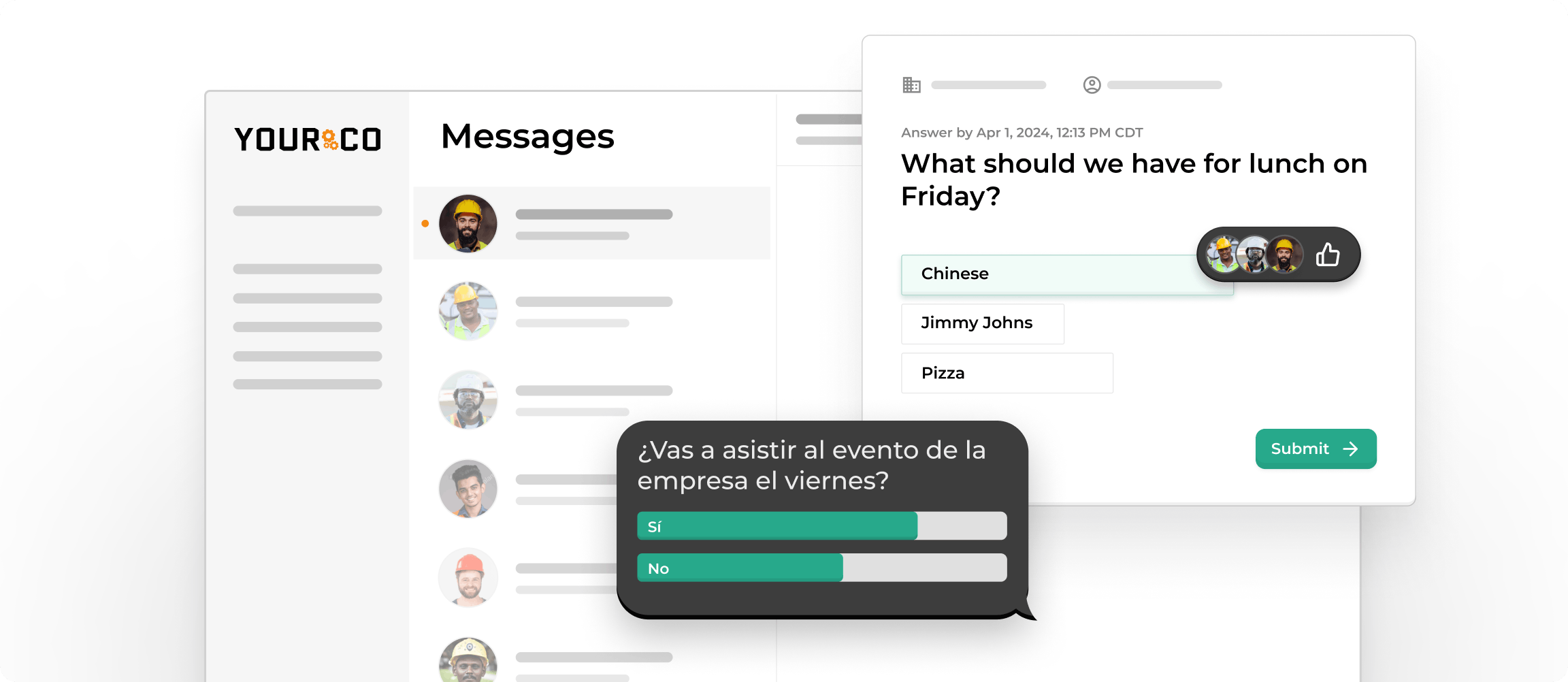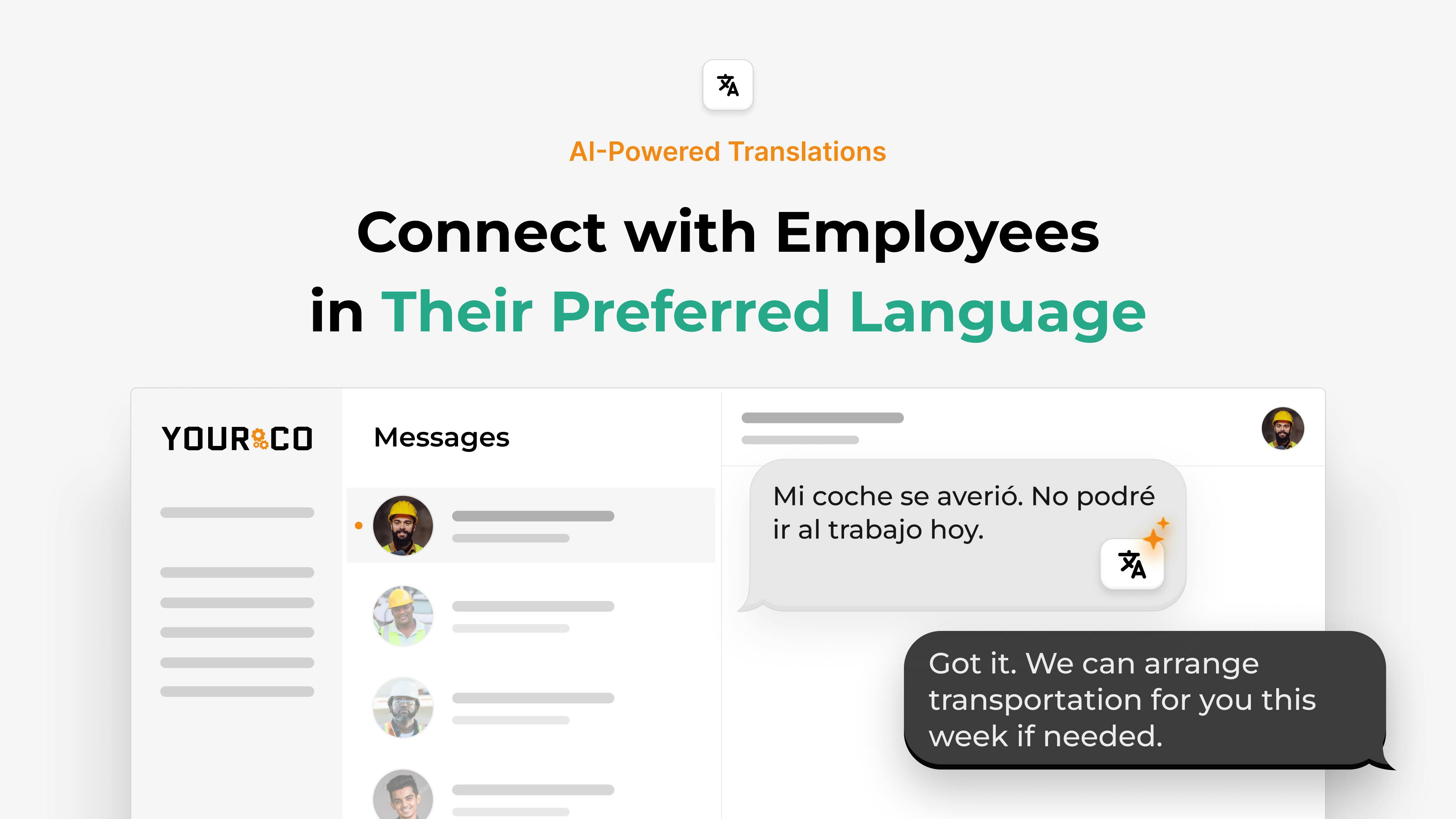Best Follow-Up Questions for Employee Satisfaction Surveys: A Complete Guide


Employee satisfaction surveys give you a starting point for understanding employee sentiment, but the real work begins after you collect the scores. When you see a low rating for "manager support" or "workplace safety," you know something needs attention, but you don't know what specific changes will help. Follow-up questions after the initial survey bridge that gap, turning vague ratings into clear, actionable insights that you can address.
Employees notice when you take their opinions into account. They see that their feedback matters enough for you to ask clarifying questions and take concrete steps. This builds trust and encourages more honest participation in future surveys.
This guide provides ready-to-use follow-up questions organized by common survey themes, so you can move quickly from raw scores to specific problems you can solve.
Why Follow-Up Questions Matter
Follow-up questions transform raw survey scores into actionable insights you can fix. Without them, a "3 out of 5" sits on a dashboard with no clue what needs attention. When you circle back and ask employees to explain their rating, you demonstrate that their voice matters. This simple step builds trust, especially when you share how their feedback influenced decisions.
Numbers alone rarely tell the whole story. A low score on workload might stem from broken equipment, unclear priorities, or short staffing. Thoughtful follow-up questions reveal the root cause, giving you clear targets for improvement. That clarity transforms feedback into action.
Trust grows when employees feel safe answering. Anonymity, plain language, and quick follow-ups signal that you want honest input, not rehearsed responses.
Frontline and non-desk workers benefit most from structured follow-ups. They juggle shifts, limited email access, and noisy environments, so structured follow-ups via SMS are among the clearest channels available for them to raise concerns. When you ask and act on their input, you close the gap between headquarters and the shop floor, boosting morale, retention, and daily performance.
Choose the Right Time and Method for Follow-Up Questions
The success of your follow-up questions depends on reaching employees when they're ready to respond through channels they actually use. Several key factors determine whether you'll get honest, actionable feedback or minimal participation.
Timing Matters Most When Collecting Follow-Up Feedback
Reach out within two weeks of your survey closing to keep responses fresh and relevant. You can weave follow-up questions into existing touchpoints like one-on-ones, team huddles, or send a brief pulse survey.
Match Your Communication Channel to How Your Team Works
Anonymous SMS or text links work best for non-desk staff who need to respond on the go, especially since most never check email regularly. Direct conversations build stronger relationships, though some workers may hold back criticism when speaking face-to-face. Short online forms collect answers quickly but can feel impersonal. Focus groups provide deeper context for complex issues but require more scheduling time. Choose the right communication channel based on your workforce's daily routines and preferences.
Psychological Safety Drives Honest Responses
Creating an environment where employees feel comfortable sharing their thoughts requires several key elements:
- Allow anonymous feedback whenever possible
- Use straightforward, non-judgmental language
- Clearly state that comments won't be used against anyone
- Frame questions with curiosity rather than blame
Simple phrasing like "We're looking to improve your daily experience" shows genuine interest in understanding their perspective rather than finding fault.
Always Communicate What Happens Next
Share what you heard, explain the actions you plan to take, and provide a timeline for changes. This transparency builds trust and keeps future response rates high, ensuring your feedback loop remains strong and effective.
Make Participation Easy for Everyone
Text-based follow-ups reach teams across shifts and languages without requiring app downloads or computer access. This approach works especially well for dispersed teams across different sites who may have varying levels of technology access. The simpler you make it to participate, the more honest insights you'll collect.
Dig Deeper Into Survey Themes With These Follow-Up Questions
Once the initial survey results are in, you need pointed follow-ups that nudge employees to share stories, examples, and workable ideas. The prompts below are grouped by common engagement themes, drawing on proven wording used in high-participation tools like pulse texts and kiosk surveys. They land well with deskless crews who may only have a minute between tasks. Feel free to lift the language verbatim or adapt it to match your tone.
Address Low Satisfaction Scores
When your first survey reveals low ratings, send follow-up questions to learn the story behind those numbers. You need context to understand whether this reflects a recent incident, a long-term problem, or something specific to their role. These questions can help:
- Initial question: "Can you share more about what contributed to your rating?" Opens the conversation and encourages employees to share without feeling defensive.
- Follow-up question: "Was this score based on a recent experience or a long-term trend?" Clarifies whether the issue is isolated or ongoing.
- Specific question: "What specific factors influenced your response to this question?" Identifies the root causes behind the score.
- Solution-oriented question: "If you could change one thing that would improve your satisfaction, what would it be?" Shifts the focus toward actionable improvements.
- Urgency gauge: "On a scale of 1–10, how much does this issue impact your daily work experience?" Helps prioritize issues based on their impact.
Strengthen Managerial Support and Leadership
If frontline employees hesitate to criticize managers directly in the initial survey (as many usually do), your follow-up questions need to feel safe and constructive. Here's how a typical sequence might go when gathering feedback on management support:
- Initial question: "What could your manager do differently to support you better?" Frames the conversation around improvement rather than blame.
- Follow-up question: "Are there recent examples where you felt unsupported or unheard?" Encourages employees to share specific situations that can be addressed.
Communication patterns matter just as much as individual interactions. Ask these questions:
- Initial question: "How would you describe the communication from leadership to your team?" Reveals how effectively information flows within the organization.
- Follow-up question: "What types of recognition or feedback from your manager are most meaningful to you?" Highlights positive practices that can be reinforced.
- Accessibility question: "How comfortable do you feel approaching your supervisor with questions or concerns?" Tests psychological safety and openness in the workplace. If people don't feel safe speaking up, other issues will stay hidden.
Improve Recognition and Appreciation
Recognition means different things to different people, especially across diverse frontline teams. Ask these questions in your follow-up survey to assess recognition practices:
- Initial question: "What type of recognition feels meaningful to you?" Identifies individual preferences for acknowledgment.
- Follow-up question: "Have you felt appreciated for your work in the past month? If so, how?" Checks for recent positive experiences.
- Deeper exploration: "Can you describe a time when you felt truly valued at work?" Reveals what genuinely motivates and engages employees.
- Forward-looking question: "What could the company do to show appreciation for your contributions better?" Generates actionable ideas for improvement.
- Fairness check: "Do you feel recognition is distributed fairly across teams and roles? Why or why not?" Surfaces potential systemic issues.
Enhance Team Dynamics and Communication
Team communication looks different for deskless workers who may rarely gather in one place. Here's how a typical sequence might go in a follow-up survey when evaluating communication effectiveness:
- Initial question: "Do you feel comfortable speaking up during daily communications? Why or why not?" Gauges psychological safety and whether employees withhold important information or concerns.
- Follow-up question: "What would help improve communication within your team?" Identifies opportunities for strengthening internal interactions.
- Cross-team check: "How effective is information sharing between departments or shifts?" Reveals communication gaps that impact productivity and morale.
- Barrier assessment: "What barriers prevent effective collaboration with your colleagues?" Pinpoints obstacles to teamwork.
- Timeliness question: "Do you receive the information you need in a timely way? If not, how could this be improved?" Highlights simple fixes that can deliver immediate benefits.
Expand Career Growth and Development
Many frontline employees feel stuck without clear advancement paths. You can structure your follow-up questions after the initial survey to uncover both personal goals and systemic barriers:
- Initial question: "Do you feel like you're growing here? If not, what's missing?" Gauges overall satisfaction with professional growth opportunities.
- Follow-up question: "What skills would you like to develop that aren't being supported right now?" Identifies specific development needs.
- Visibility check: "Are you aware of potential career paths within the company? How could we make them clearer?" Assesses awareness of advancement opportunities.
- Training needs: "What additional training would help you feel more confident in your role?" Pinpoints practical ways to build skills and confidence.
- Obstacle assessment: "What obstacles do you face in advancing your career here?" Surfaces structural or cultural barriers to growth.
Balance Work-Life and Reduce Burnout
If your first survey flags workload strain, stress, or scheduling challenges, send follow-up questions to dig into what's driving those issues and how they can be eased. Workload and stress often build gradually before they appear in metrics, so these targeted questions help you catch problems early and act before burnout sets in:
- Initial question: "How manageable is your workload lately?" Provides a real-time view of workload demands.
- Follow-up question: "Have you felt stressed or overwhelmed at work? What's contributing to that?" Pinpoints specific stressors.
- Flexibility check: "Are your work schedules flexible enough to meet your personal needs?" Assesses how well scheduling supports employees' lives outside work.
- Support question: "How supported do you feel when personal matters require flexibility?" Highlights gaps in empathy and policy.
- Action-oriented question: "What changes could improve your work-life balance?" Generates practical ideas that can lower stress and reduce turnover.
Build Company Culture and Belonging
Inclusion challenges can be subtle but have a big impact on retention and engagement. When your first survey points to inclusion or culture alignment concerns, use these follow-up questions that uncover both opportunities for improvement and strengths to protect:
- Improvement question: "What's one thing we could do to make everyone feel more included?" Invites actionable suggestions.
- Experience check: "Have you ever felt out of place or excluded at work?" Surfaces personal experiences that might not appear in metrics.
- Values alignment: "Do you feel the company values align with your personal values? Why or why not?" Assesses cultural fit and potential friction.
- Authenticity question: "How comfortable do you feel being your authentic self at work?" Measures psychological safety and belonging.
- Strengths to preserve: "What aspects of our culture would you never want to see change?" Ensures valuable cultural traits are protected.
Improve Work Environment and Safety
Physical working conditions directly affect both safety and morale for frontline teams. Here's how a typical sequence might go when assessing workplace safety after the initial survey:
- Initial question: "What aspects of your physical work environment could be improved for your comfort and safety?" Gathers broad feedback on what workers perceive as issues.
- Follow-up question: "Are there any recurring safety hazards or equipment issues you encounter?" Gets more specific about root causes and hazards.
Resource availability affects job performance and frustration levels. Questions when assessing resource access and preparedness might be:
- Initial question: "Do you have access to all the resources and equipment needed to do your job successfully?" Establishes whether workers feel equipped to meet daily expectations.
- Follow-up question: "How confident are you in the company's emergency procedures?" Tests readiness and safety preparedness in critical situations.
- Closing question: "What workplace improvements would have the biggest positive impact on your daily experience?" Prioritizes changes that matter most to the team.
Frame Follow-Up Conversations for Success
Start every follow-up with genuine curiosity. When employees sense that you want to understand, not judge, they open up. Use plain, supportive language and remind them that feedback stays confidential. This builds trust from the first question.
Open-ended questions get you better answers. Instead of asking, "Do you feel heard?", try, "Can you share a recent time you felt unheard, and what would have helped?" Pair a quick rating with a "why" question. This gives you both a number to track and the story behind it.
Be clear about what happens next. Employees get skeptical when feedback disappears into a black hole. After the conversation, share what you heard, outline your next steps, and set a date to report back. If you plan to create an action plan, say so upfront and invite employees to help shape priorities.
Meet people where they are. Use clear language without jargon, offer translation when needed, and choose accessible channels like SMS for non-desk staff. Most people with phones are able to receive and read text messages, with little to no device limitations, service issues, or accessibility needs. Start with broad questions, then drill down as people get comfortable. Close by thanking employees for their honesty — you show respect, and they leave knowing their voice matters.
Get Better Follow-Up Results with Yourco
Following up on employee feedback is where real change begins, and Yourco makes that process faster, clearer, and more inclusive. With SMS-based follow-ups, you can reach every team member, even those without email or smartphone access, and collect real-time input that leads to action.
Whether you're checking in on safety concerns, team dynamics, or recognition gaps, Yourco supports anonymous pulse surveys, open-text replies, and ongoing feedback loops through simple text messages. You can schedule follow-up questions by shift, role, or location. And with AI-powered translations, every message is automatically delivered in the employee's preferred language, so everyone understands and has a chance to participate.
Most importantly, our platform doesn't just gather feedback. It helps you act on it. You can confirm receipt of updates, follow up on unresolved issues, and share progress with employees in a way that builds trust. When workers see that their feedback leads to visible change, they stay engaged and motivated to keep the conversation going.
Ready to turn surveys into progress? Try Yourco for free today or schedule a demo and see the difference the right workplace communication solution can make in your company.
FAQs
Can Yourco help us follow up on employee survey responses?
Yes. Yourco makes it easy to send SMS-based follow-up questions directly to employees after a satisfaction survey. You can target messages by shift, role, or location and gather real-time responses without needing email or apps. This helps you clarify low scores and turn vague feedback into clear next steps.
How does Yourco support anonymous feedback?
Yourco enables anonymous participation in surveys and follow-up questions. Responses can be collected through secure SMS links or simple reply messages without tying responses to individual names. This encourages honest input, especially from frontline workers who may be hesitant to speak up face-to-face.
What if our workforce speaks multiple languages?
Yourco includes built-in AI-powered translation for over 135 languages and dialects. Follow-up questions and employee responses are automatically translated into each person's preferred language, making it easy to gather inclusive feedback across a diverse, multilingual workforce.
How do we keep track of follow-up responses over time?
All responses, messages, and follow-up interactions are logged and stored in Yourco's dashboard. You can review trends, monitor participation, and export records to help guide action planning and compliance reporting. This ensures your feedback loop stays organized, visible, and audit-ready.




